On This Page
What Does a Wood Thrush Look Like?
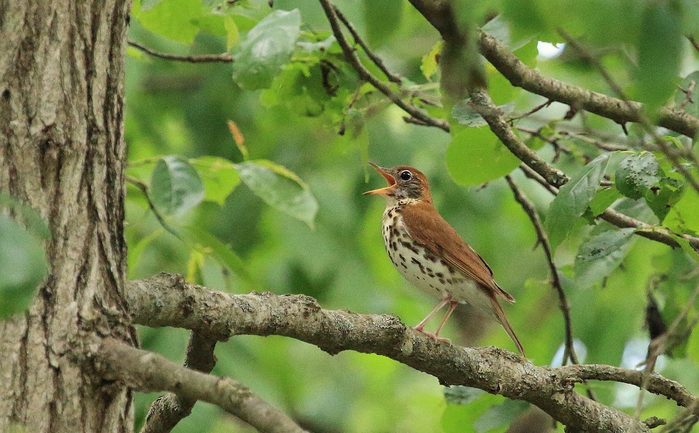
There are very few birds with songs that can rival the dreamy notes and complex trills of the wood thrush. These forest-dwelling birds can be hard to spot. Their field markings give them great camouflage that allows them to blend in with their surroundings.
“Most often you’ll hear them and not see them,” says Zach Ladin, an ecologist for U.S. Fish and Wildlife Service. Thrush species, including wood thrush, are known for their dreamy, flute-like song and complex trills. “For this reason, identifying wood thrushes by their song is a great method,” Zach says.
But if you are on the search, it’s easiest to spot them on the ground. Wood thrushes are medium-sized birds and larger than other thrush species, like hermit and Swainson’s thrushes. Both male and female wood thrushes have dark, bold spots on their chests and rich, cinnamon coloring on their backs and heads. Their large eyes help them spot bugs in thick, shady forests.
Learn to identify more small brown birds you might see.
Wood Thrush Habitat and Range
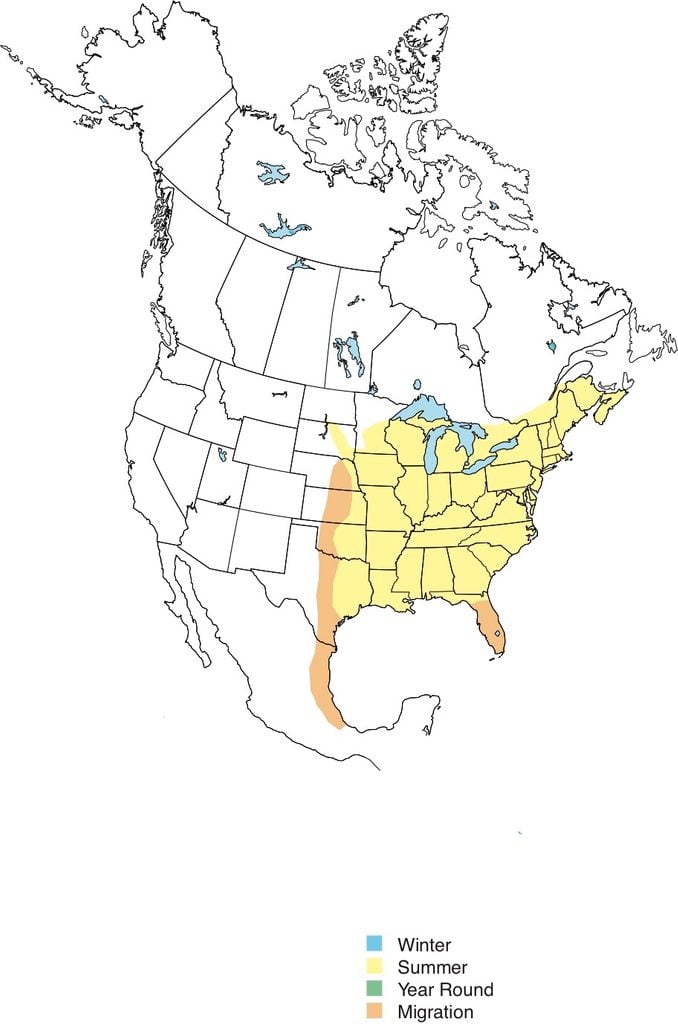
Range maps provided by Kaufman Field Guides, the official field guide of Birds & Blooms.
Wood thrushes live in the Midwest and eastern U.S. and stick to deciduous and mixed forests with dense undergrowth during their breeding season from May to August. When the weather gets colder, they head south to Central America.
Although wood thrushes are considered a common bird, their numbers have been declining since the 1950s due to loss of habitat and forest fragmentation.
“When forest habitat is reduced, there may be less food available and an increase in negative effects from predators and nest parasitism from brown-headed cowbirds,” says Zach. “We must take a holistic approach and work with international partners to protect habitats. We can protect those areas for birds and protect critical ecosystems that support life on Earth for humans — it’s a win-win.”
Learn how to identify a varied thrush.
Nesting Habits
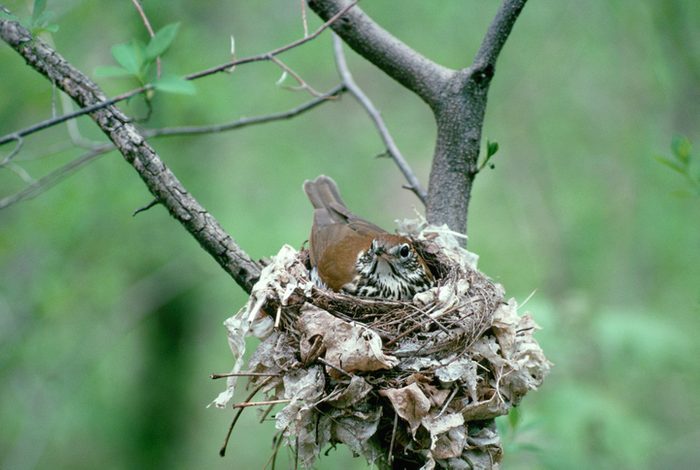
“Wood thrushes tend to build their nests in the forks of branches of understory shrubs or young trees,” says Zach. “On average, nest height is around 13 feet high but can range between two feet and over 90 feet from the ground.” The male finds and establishes the breeding ground. After courtship activities, like mutual feeding, the female selects the nest site.
Their nests are cup-shaped and lined with leaves, grass and, similar to American robins, a layer of mud. Sometimes they incorporate manmade materials, like cellophane and bits of paper, into the nest structure, too. Each nest holds three to four eggs.
A pair of wood thrushes will usually raise two broods per season in two separate nests. (Both parents feed the fledglings at first, and then the male continues feeding them after the female lays her next clutch of eggs.) Although wood thrush pairs raise their young together, they’re not monogamous. It’s relatively common for fledglings in a single brood not to share the same father.
One of the biggest challenges wood thrushes face during breeding season is contending with brown-headed cowbirds. This has been made worse by loss of habitat. “In a long-term study we conducted on wood thrushes in a fragmented landscape in Delaware, we found that despite having plenty of high-quality food, wood thrushes were negatively affected by brown-headed cowbirds, which lay their eggs in wood thrush nests,” Zach says.
Caring for and feeding the young cowbirds takes up the energy and time of the parent wood thrushes often at the fatal expense of their own young.
Diet: What Does a Wood Thrush Eat?
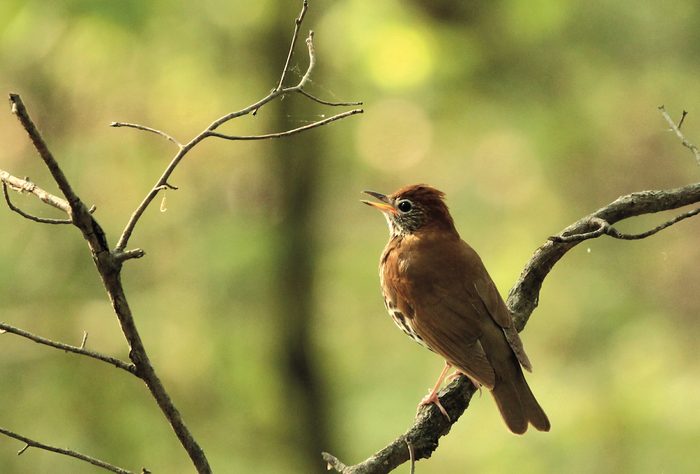
Wood thrushes hop along the forest floor and hunt for insects in the soil and under leaves. “They often forage in the leaf litter for invertebrates including snails and spiders,” says Zach. The shells of snails are an important source of calcium for female wood thrushes during breeding season. Small fruits and berries are also important items on the wood thrush menu, especially in late summer when they are preparing to migrate south.
However, if you’re hoping to attract wood thrushes to your backyard, you’re facing an uphill battle. “Wood thrushes are not your typical backyard bird, because they prefer mature forests with moderate understory vegetation,” says Zach. “But if you live on the edge of a forest or forest patch in the eastern U.S., you may have wood thrushes nearby during the breeding season.”
Wood Thrush Song
Bird sounds courtesy of the Cornell Lab of Ornithology
This species’ recognizable song is usually written out as ee-oh-lay but there’s a lot of complexity behind it. “Wood thrushes belong to a group of related thrush species that are known for having some of the most extraordinary songs in the bird world,” says Zach. “By passing wind through both sides of its vocal organ, called a syrinx, a wood thrush can generate its beautiful song with many overtones to create a rich, harmonic sound.” Essentially, it’s as though the bird is singing a duet with itself.
Because of all the different pitch and note variations available to these birds, a single male may sing up to 50 distinct versions of its song.
About the Expert
Zach Ladin is an ecologist who works in the Division of Migratory Birds in the U.S. Fish and Wildlife Service. He’s passionate about integrating ecological data and novel technologies to inform how humans can promote ecosystem health and function in light of increasing rates of global urbanization and climate change.
Sources
- National Geographic Backyard Guide to the Birds of North America: Jonathan Alderfer and Paul Hess
- All About Birds
- National Audubon Society
- American Bird Conservancy
- Smithsonian’s National Zoo & Conservation Biology Institute
Why Trust Us
For nearly 30 years, Birds & Blooms, a Trusted Media Brand, has been inspiring readers to have a lifelong love of birding, gardening and nature. We are the #1 bird and garden magazine in North America and a trusted online resource for over 15 million outdoor enthusiasts annually. Our library of thousands of informative articles and how-tos has been written by trusted journalists and fact-checked by bird and garden experts for accuracy. In addition to our staff of experienced gardeners and bird-watchers, we hire individuals who have years of education and hands-on experience with birding, bird feeding, gardening, butterflies, bugs and more. Learn more about Birds & Blooms, our field editor program, and our submission guidelines.
On This Page
What Does an American Redstart Look Like?
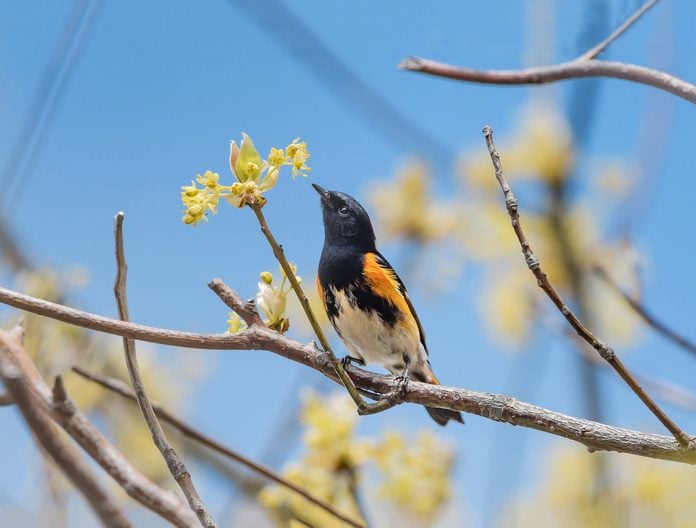
Bright yellow plumage is common among warblers, but the vibrant American redstart is distinctive. Males are mostly black, but bright orange patches on their sides, wings and tails help them stand out from leafy foliage.
“A lot of warblers can be tricky because they resemble other warblers, but there’s nothing like redstarts,” says Bill Rowe, president of St. Louis Audubon Society. “They’re immediately recognizable. The adult males, especially, but the females, too.”
Females have a more muted color scheme—their gray heads and dark wings are less eye-catching than the colors of their mate. Females have a patch of yellow on their sides, and a muddy yellow coloring extends to their tail and wings.
American Redstart Behavior
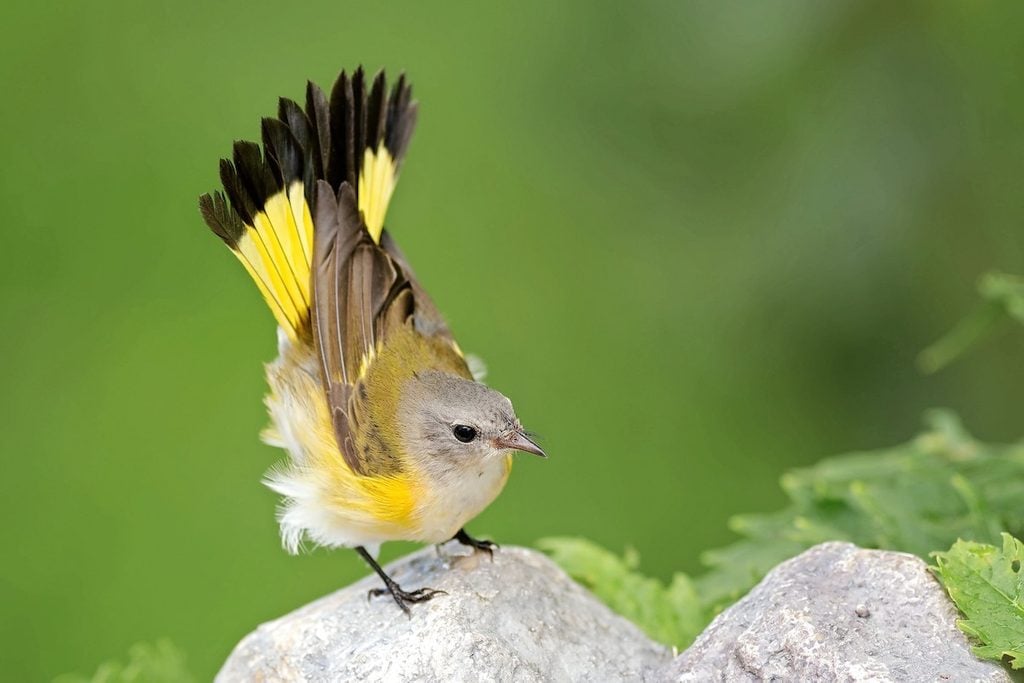
Redstarts are among the most active warblers. As a notable behavioral quirk, they tend to fan out their tails as they move, which makes them easy to identify.
“Theoretically, they do that to flush insects out so they can catch them in flight,” explains Dr. Kevin McGowan, senior course developer for the Cornell Lab of Ornithology’s Bird Academy. “They do a lot of fly-catching, so they’re trying to frighten the insects that are hiding into revealing themselves by flying away.”
Discover more fascinating facts about warblers.
American Redstart Habitat and Range
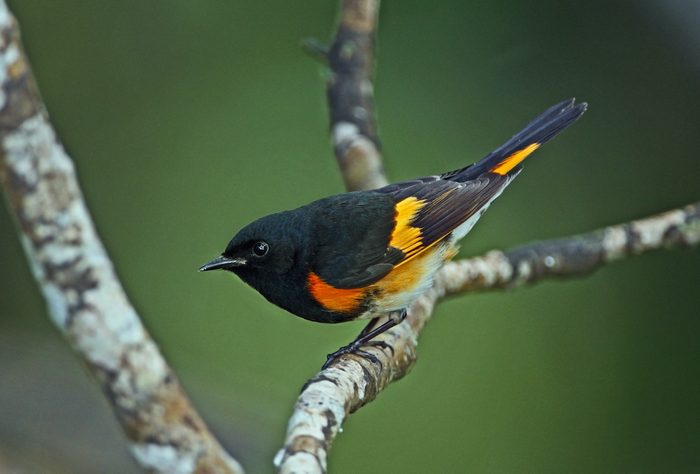
If you’re birding in spring on the edges of eastern forests, be sure to look for redstarts. While they migrate through much of the United States (with the exception of California), they remain for breeding season in the Midwest, Northeast, and a few Southern states such as Alabama and Louisiana.
Redstarts, like many warblers, prefer a forest habitat. In some sections of their range, birders can find them in woods along rivers or even in orchards.
“They’re one of the easiest [warblers] to observe,” says Bill. “Partly because they’re common, but also because many warblers are either high up in the trees most of the time, or they’re hiding in shrubbery. Redstarts like to hang out in somewhat open areas, where they will flit around and hunt for food.”
Learn how to identify yellow-rumped warblers.
American Redstart Diet
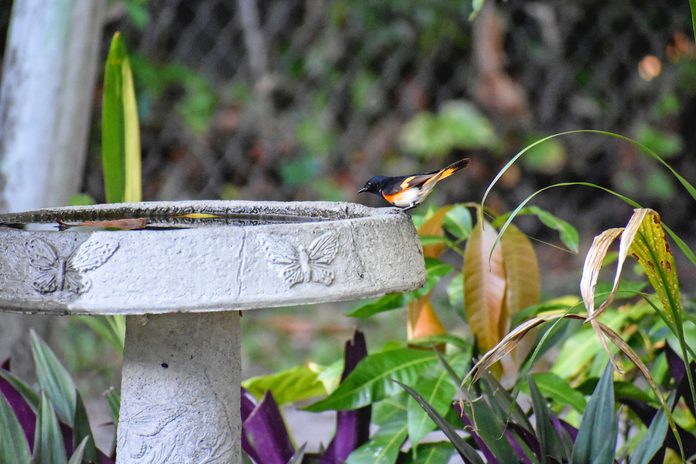
Like most warblers, redstarts usually aren’t interested in bird feeders. Primarily eating bugs, they’re known to dine on flies, moths, beetles, and other insects. They’ll also eat berries from time to time, especially barberry, serviceberry, and magnolia.
Unlike common songbirds, they don’t eat seed—but you might be able to attract warblers into your yard with a bird bath.
Bill says that if you live in the redstart’s migrating range and preferred habitat, all you really need to do is go outside and birdwatch in your yard. “Sooner or later, you’ll see one of the groups of migrants,” he says. “It varies day by day. Watch for movement in the trees.”
Yellow warbler vs goldfinch: learn how to tell the difference.
Nest and Eggs
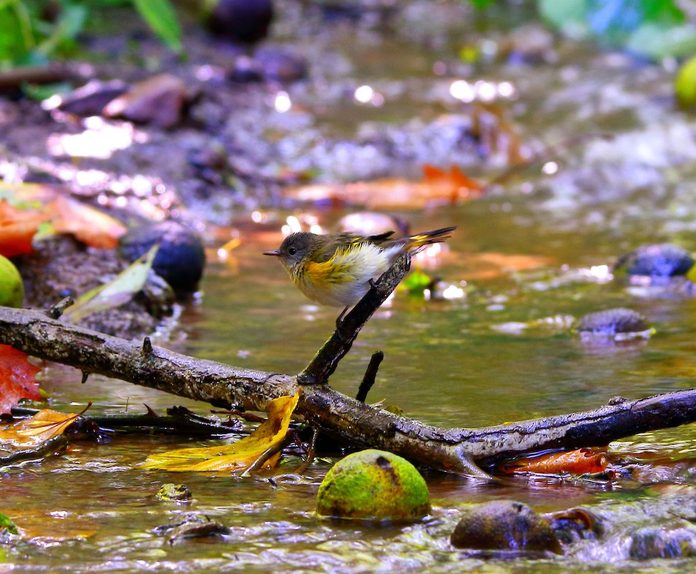
After constructing a nest, a female redstart lays a clutch of one to five eggs. She incubates the eggs for up to two weeks, and young birds remain in the nest for up to two weeks more. The male and female both take part in feeding the fledglings.
“The first-year males look like females,” Kevin says. “When they come back in the spring, they will sing and try to attract a mate, and it looks like a female that’s singing, but it’s actually a male. They get adult plumage the second year.”
Attract a prothonotary warbler with a birdhouse
American Redstart Song
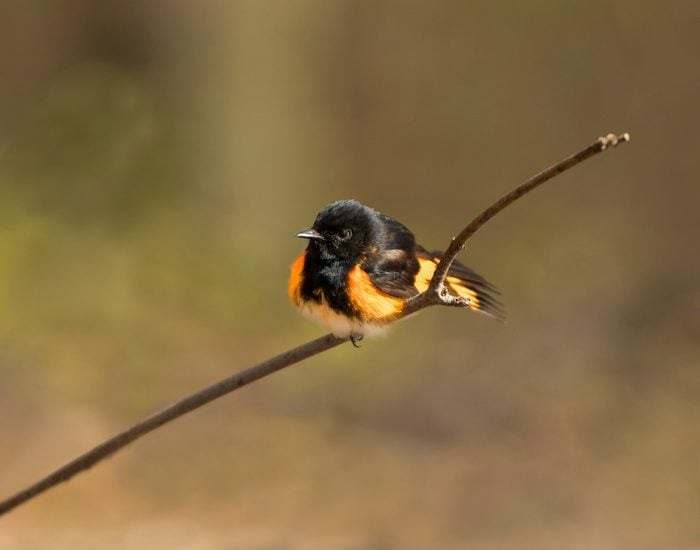
This warbler’s high-pitched, variable song often ends in a sharp shew. Some birders compare the sound to a sneeze.
Bird songs courtesy of the Cornell Lab of Ornithology.
Want to learn more about warblers? Meet the magnolia warbler and black-and-white warbler.
About the Experts
Lifelong birder and ornithologist Dr. Kevin McGowan is a senior course developer for the Cornell Lab of Ornithology’s Bird Academy. He earned a Ph.D in biology at the University of South Florida.
Bill Rowe is the president of St. Louis Audubon Society. Throughout his many years of volunteering and serving on the Board, he has written “Bird of the Week” columns, led field trips and private birding tours, and taught birding classes.
Sources
Why Trust Us
For nearly 30 years, Birds & Blooms, a Trusted Media Brand, has been inspiring readers to have a lifelong love of birding, gardening and nature. We are the #1 bird and garden magazine in North America and a trusted online resource for over 15 million outdoor enthusiasts annually. Our library of thousands of informative articles and how-tos has been written by trusted journalists and fact-checked by bird and garden experts for accuracy. In addition to our staff of experienced gardeners and bird-watchers, we hire individuals who have years of education and hands-on experience with birding, bird feeding, gardening, butterflies, bugs and more. Learn more about Birds & Blooms, our field editor program, and our submission guidelines.
On This Page
Collect Milkweed Seeds From Pods
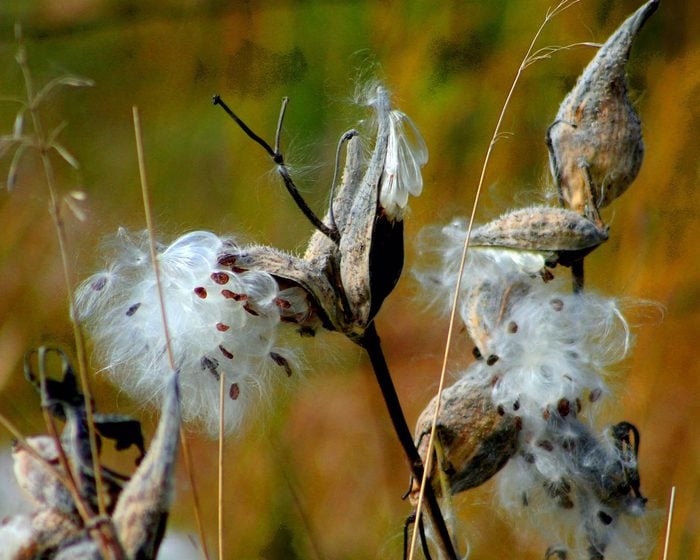
“I collected some dried pods from common milkweed last year. What’s the best way and time to plant the seeds from the milkweed pods?” asks Birds & Blooms reader Judy Roberts.
Horticulture expert Melinda Myers says, It’s hard to believe a plant that readily starts from seed in nature can be challenging for us to do the same. Before planting milkweed, keep in mind that common milkweed quickly forms colonies and can overrun a garden. Others, such as butterfly weed and swamp milkweed, are less aggressive and still support monarch butterflies.”
The seeds must be mature to sprout, so collect seeds just before or as the pods split open after the flowers stop blooming. Melinda says, “Start by removing any seeds remaining in the pods, saving only rich brown seeds that are mature and viable. It’s best to separate seeds from the white fluff, called coma, before drying and storing. You can do this by holding the seeds while in the pod and pulling off the fluff, rubbing the seeds between the palms of your hands or placing them in a paper bag and shaking vigorously.”
You could also consider tying small bags over the milkweed pods while they mature, since many distribute their seeds far and wide (especially common milkweed).
“After the pods on my milkweed plants open, I take the seeds and shake them into envelopes that I’ve labeled with the year the seeds were collected,” says reader Patrick Hogan.
Is tropical milkweed bad for monarchs? Is honeyvine milkweed invasive? Here’s what you need to know.
Milkweed Seed Cold Stratification
You will need to store seeds in the refrigerator or an airtight container in a cold place for several months. This cold treatment is needed to end dormancy and increase sprouting success.
Melinda recommends, “Next, store the dry seeds in an airtight container in the refrigerator until you are ready to process them for planting. Provide seeds with cold, moist stratification to break dormancy right before planting. Place the seeds in a damp paper towel inside a plastic bag, or with sand or vermiculite in a container. Put in the refrigerator for at least 30 days.”
Check out even more of the best types of milkweed to support monarch butterflies.
When to Plant Milkweed Seeds
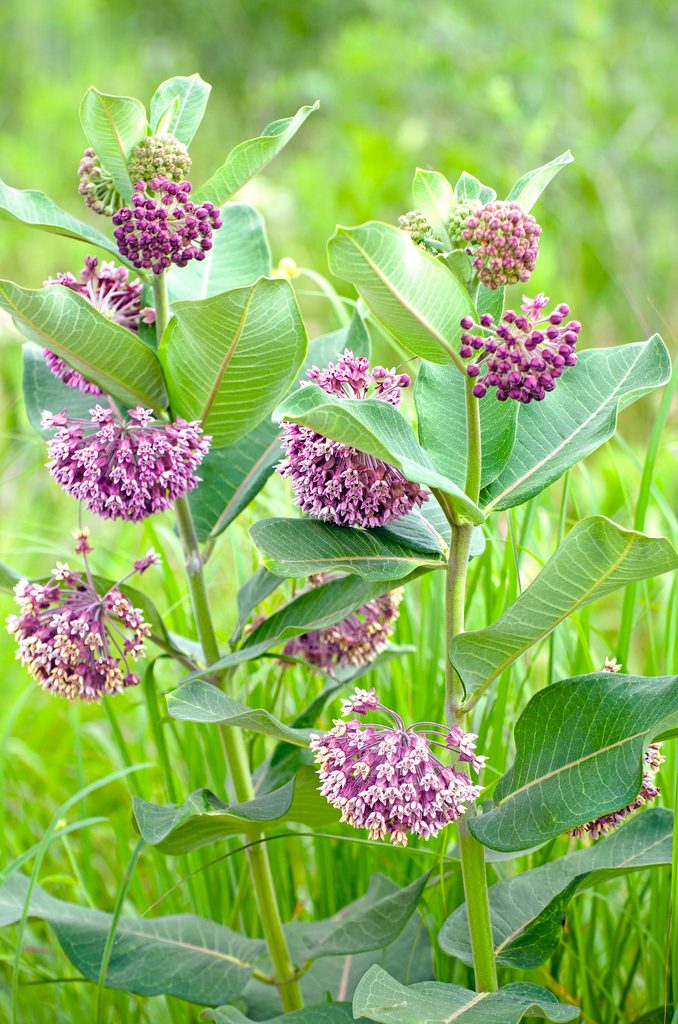
Melinda says, “Once stratified, you can start the seeds indoors or plant them directly in the garden after the last spring frost. Or let nature do the work with winter sowing. Look up instructions online for converting a plastic milk jug into a vessel for starting these and other seeds outdoors. In the future, consider mimicking nature and planting the seeds directly in the garden during fall.”
If it’s possible, start your seeds indoors under artificial lights in a quality potting or seed-starting mix. The seedlings will be ready to transplant in the garden once they are 3 to 6 inches tall and when the threat of the last spring frost has passed. Plan for about four to eight weeks of indoor growing time.
You can also plant seeds directly outdoors. Fall is the best time to direct-sow the seeds for gardeners in cold climates. Many milkweed varieties contain hard coatings that have to break down before the seeds will germinate. Exposure to a winter’s worth of snow and cold, wet weather will do just that.
Check out the Monarch Joint Venture for more information on how to collect seeds from milkweed pods. To order seeds, contact the Live Monarch foundation.
Next, learn how to get rid of aphids on milkweed plants.
About the Expert
Melinda Myers is the official gardening expert for Birds & Blooms. She is a TV/radio host, author and columnist who has written more than 20 gardening books. Melinda earned a master’s degree in horticulture from the University of Wisconsin-Madison.
Sources
- Monarch Joint Venture
- Live Monarch Foundation
Why Trust Us
For nearly 30 years, Birds & Blooms, a Trusted Media Brand, has been inspiring readers to have a lifelong love of birding, gardening and nature. We are the #1 bird and garden magazine in North America and a trusted online resource for over 15 million outdoor enthusiasts annually. Our library of thousands of informative articles and how-tos has been written by trusted journalists and fact-checked by bird and garden experts for accuracy. In addition to our staff of experienced gardeners and bird-watchers, we hire individuals who have years of education and hands-on experience with birding, bird feeding, gardening, butterflies, bugs and more. Learn more about Birds & Blooms, our field editor program, and our submission guidelines.
If you’ve ever visited Hawaii, you’ve no doubt seen and fallen in love with plumeria (Plumeria rubra). The waxy blooms of this plant are the quintessential flower for making traditional Hawaiian leis, and the sweet scent is synonymous with the tropics. But plumeria (also called frangipani) is actually fairly easy to grow just about anywhere, as long you follow a few guidelines.
Discover the top 10 tropical plants for your garden.
On This Page
What Do Plumeria Flowers Look Like?
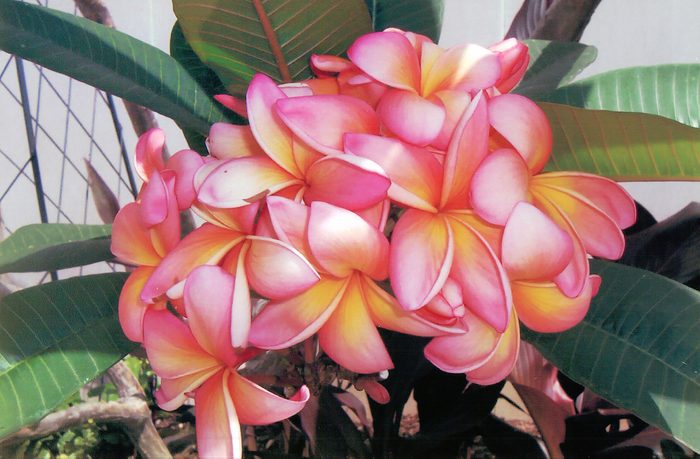
“I took this picture (above) while on vacation in Washington, D.C., outside the National Museum of American History. Do you know what kind of flower it is?” asks Birds & Blooms reader Mark Marino.
Horticulture expert Melinda Myers says, “This beautiful plant is a plumeria that is native to tropical America and has naturalized in Asia and the Pacific Islands. Visitors to Hawaii and other Pacific islands may recognize these flowers that are used to make leis.
Plumeria Care and Growing Tips
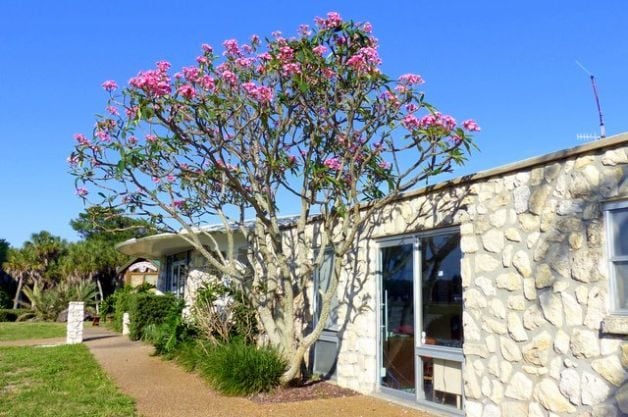
In warmer climates, you can grow plumeria outdoors year-round. If protected from frost and it will become a shrub or even a small tree (as shown above in Tampa, Florida).
“In mild climates, plumeria can grow as tall as 30 feet. In other areas it is grown in containers and moved indoors for winter. This plant needs bright sunlight; warm temperatures; moist, well-draining soil and frequent fertilization when actively growing. The fragrant flowers appear from early summer to fall,” Melinda says.
How to Grow Plumeria From Cuttings
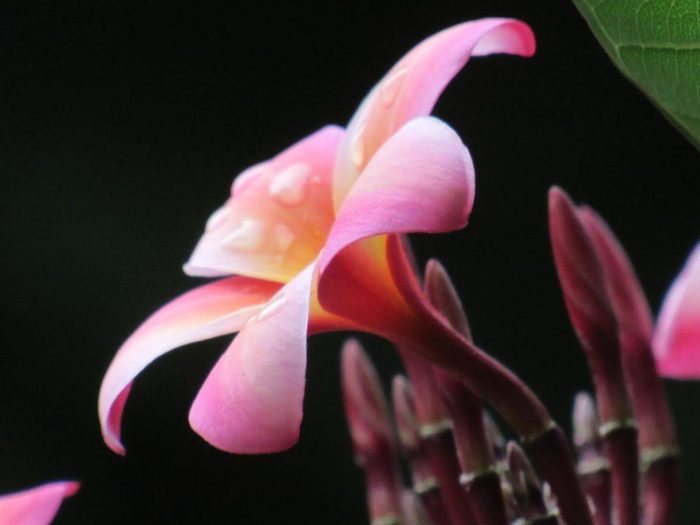
Plumeria is best grown from cuttings from a healthy plant. You can find many places to buy them online. When you order them, you will usually just receive what looks like a thick stick, without much to show for itself.
They are extremely easy to root, though. Just stick them in the soil and give them water and sun. New leaves will begin to grow within a few weeks. Plumeria produces clusters of long-lasting, sweet-smelling flowers from spring through fall, going dormant in the winter.
“My mother purchased this Hawaiian plumeria (above) from a shopping network several years ago. We affectionately referred to it as the ‘stick’ since there were no blooms for the first two years. Since neither of our thumbs are particularly green, we were thrilled and a bit surprised when these beautiful little flowers finally appeared one summer,” says reader Cathy Mcelwee.
Discover the 10 prettiest pink perennial flowers to grow.
How to Overwinter Plumeria
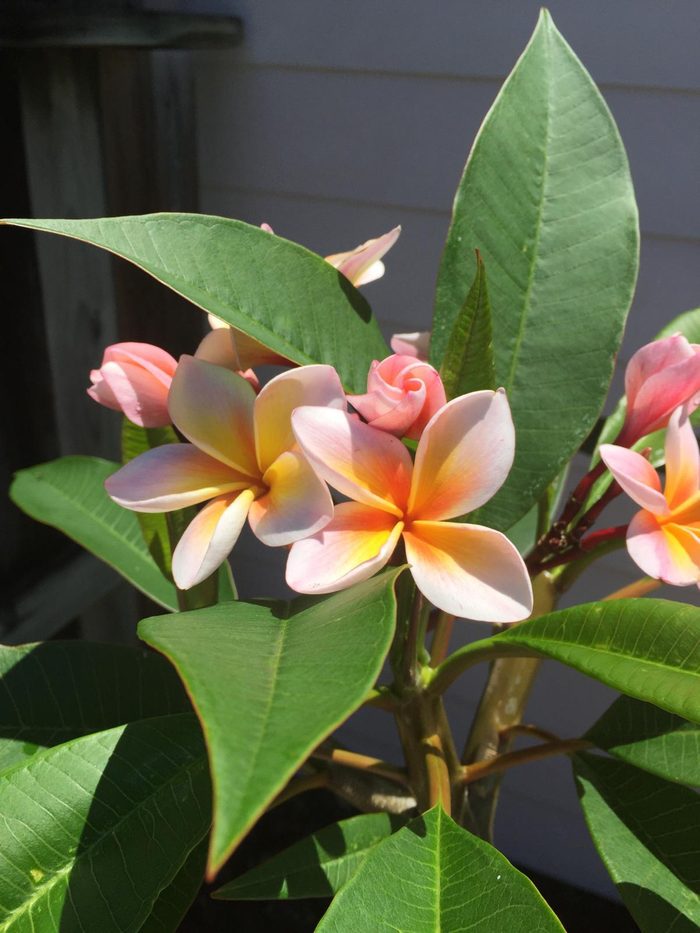
As with most tropical plants, plumeria is not cold-tolerant. In fact, it can be damaged when the temperatures fall into the 40s. (Here’s how to find the first and last frost dates). So if you grow it in any area below zone 10, you will have to take precautions in the winter.
The easiest way to do this is to grow it in a pot, and bring it inside when cool weather arrives. If you’d like to plant it outdoors, you can dig it up in the fall and keep it indoors over the winter. This is when the plant is generally dormant anyway. The Plumeria Society of America has good tips for dealing with the winter in colder climates.
Check out the top 10 flashy flowering succulents to grow.
Watering Plumeria
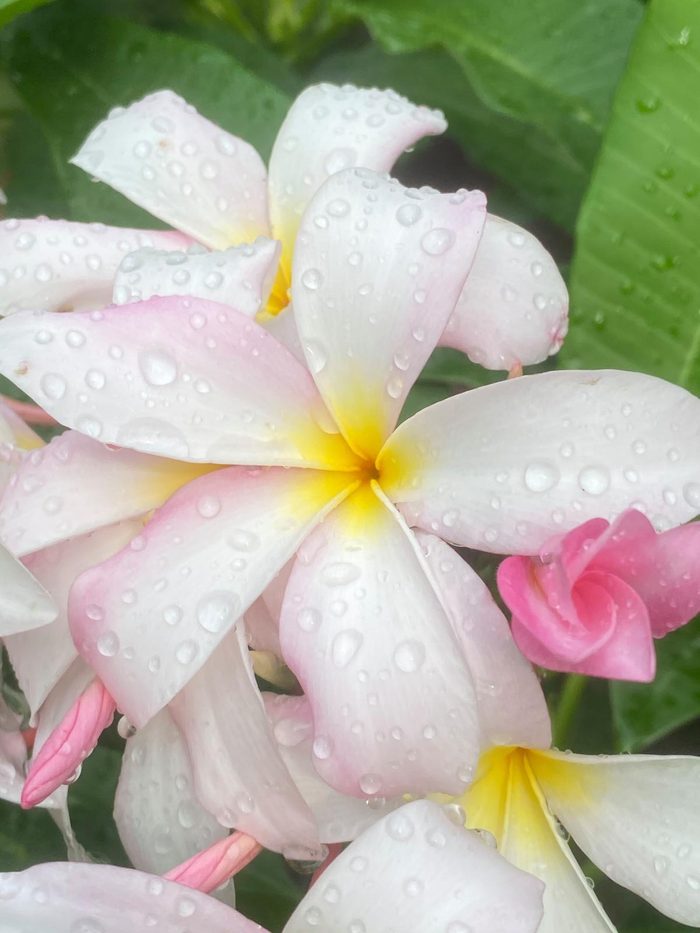
The wonderful thing about this gorgeous flowering plant is that it requires very little water, making it perfect for drought tolerant gardening. Plant it in well-draining soil (sand or sandy soil is ideal). Plumeria likes its soil to dry out between waterings, so expect to give it water once a week or so unless it receives rain.
Does Plumeria Attract Pollinators?
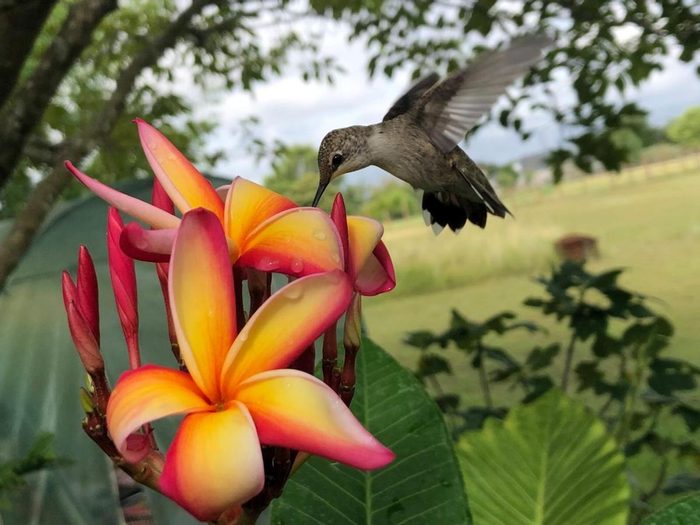
These fragrant flowers may attract bees and other pollinators. In the evening, watch for sphinx moths.
“I was in my backyard watering the plants. The plumeria bloom was beautiful, so I took a photo (above). I forgot about it by the time I went back in the house. It wasn’t until a week or so later that I actually looked at the photo and was shocked to see the visitor I had missed,” says reader Kay Smith.
About the Expert
Melinda Myers is the official gardening expert for Birds & Blooms. She is a TV/radio host, author and columnist who has written more than 20 gardening books. Melinda earned a master’s degree in horticulture from the University of Wisconsin-Madison.
Sources
- The Plumeria Society of America
- Missouri Botanical Garden
Why Trust Us
For nearly 30 years, Birds & Blooms, a Trusted Media Brand, has been inspiring readers to have a lifelong love of birding, gardening and nature. We are the #1 bird and garden magazine in North America and a trusted online resource for over 15 million outdoor enthusiasts annually. Our library of thousands of informative articles and how-tos has been written by trusted journalists and fact-checked by bird and garden experts for accuracy. In addition to our staff of experienced gardeners and bird-watchers, we hire individuals who have years of education and hands-on experience with birding, bird feeding, gardening, butterflies, bugs and more. Learn more about Birds & Blooms, our field editor program, and our submission guidelines.
On This Page
Yellow-Breasted Chat Identification
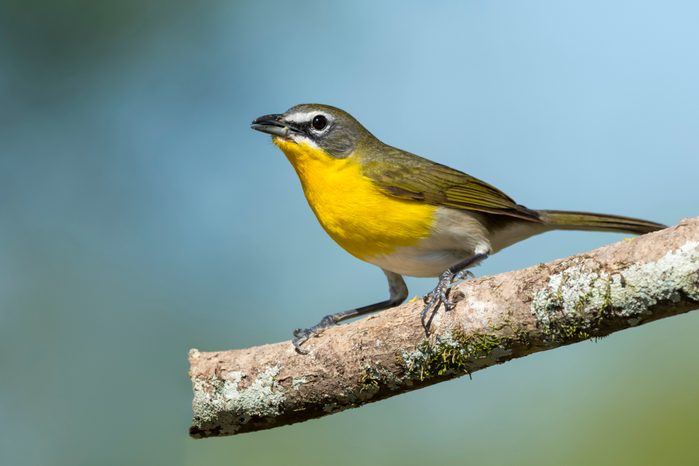
The bright yellow breast of this big-headed bird balances an olive-gray hue on its upper parts. White spectacles and mustache stripes accent its face, and a white lower belly and long tail feathers help in its identification. Males and females are similar in coloring.
Is a Yellow-Breasted Chat a Warbler?
Seven years ago, an exclusive nationwide committee of appointed senior ornithologists made a rare move—migrating the yellow-breasted chat from the warbler family into its own family based on genetic and physical characteristics. Long known scientifically as Icteria virens, the yellow-breasted chat is now alone in a new family, Icteriidae.
According to David Wiedenfeld, senior conservation scientist at the American Bird Conservancy, before that, “People thought they were really weird warblers. The vocalizations and some of their behaviors are different from any other warbler.” Importantly, they are also bigger than warblers.
David finds their flights fun to watch. “They have a characteristic flight display,” he says. “They fly 20 feet above the shrubs and trees and have this floppy butterfly kind of flight—they sort of flutter.” These birds make frequent calls during this flight display, another aspect that sets them apart from warblers.
Learn to identify 25 small yellow birds you might see.
Range and Migration
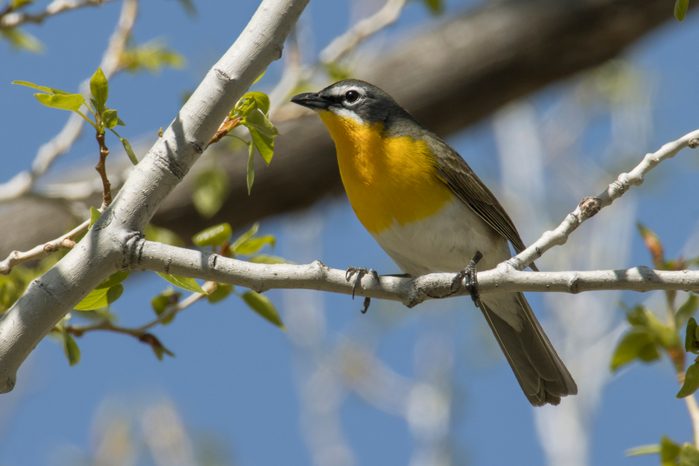
In the summer, chats are widespread in the southern U.S., north to the Great Lakes region and some areas of southwestern Canada. Most migrate south in the fall to spend the winter in Mexico or Central America.
Learn how to identify and attract a yellow-rumped warbler.
Population Numbers
The yellow-breasted chat’s numbers declined by about 32% between the mid-1960s and the late 2010s. But today, the bird is a low concern for conservation. Some states at the northern edge of the birds’ range, such as Connecticut, may consider them endangered, but farther south they are still common.
Have you ever seen a rare yellow cardinal?
Yellow-Breasted Chat Habitat
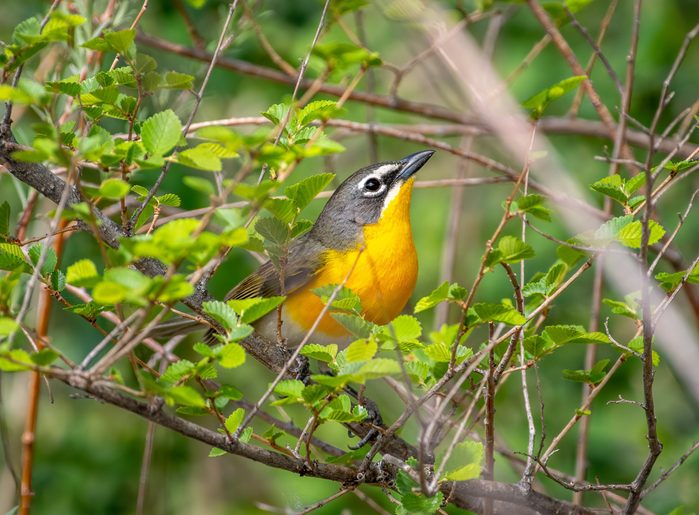
Unless your yard is full of low, thick brush, it’s hard to find this cleverly hidden bird in your backyard. Get permission to walk through old pine plantations and abandoned farm fields, or visit an accessible nature preserve.
Discover fascinating facts about warblers.
Nesting Behavior
According to the Cornell Lab of Ornithology, most males have one mate during breeding season. However, some have two, and studies have shown that females also occasionally mate outside of their otherwise monogamous partnerships. Males also display territorial flights and fights, which include grappling feet, loud thumps and audible wingbeats.
These birds make cute cup nests up to 3.5 inches across and 2.5 inches tall. They reuse abandoned nest sites, but still rebuild. The structure consists of grass, leaves, weed stems, wiry plant stems, pine needles and roots, even hair.
Look and listen for common yellowthroats in spring.
Diet: What Do Yellow-Breasted Chats Eat?
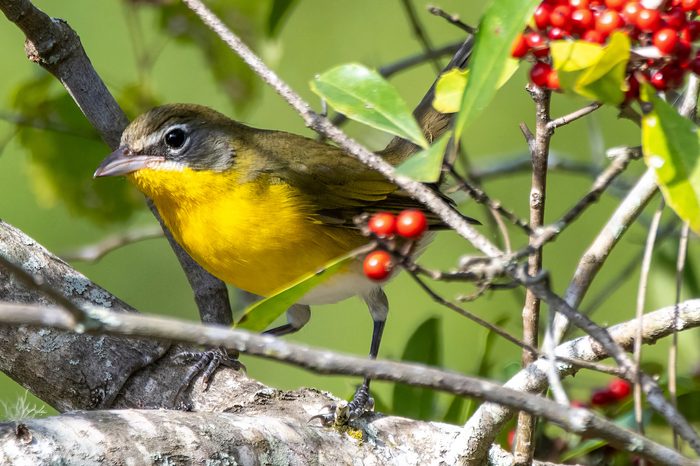
Chats are berry-loving birds. Find them in strawberry, blueberry, blackberry, raspberry or elderberry bushes, or near wild grapes. They also indulge in insects such as bugs, ants, bees, mayflies, cicadas, moths, caterpillars and beetles.
Song and Calls
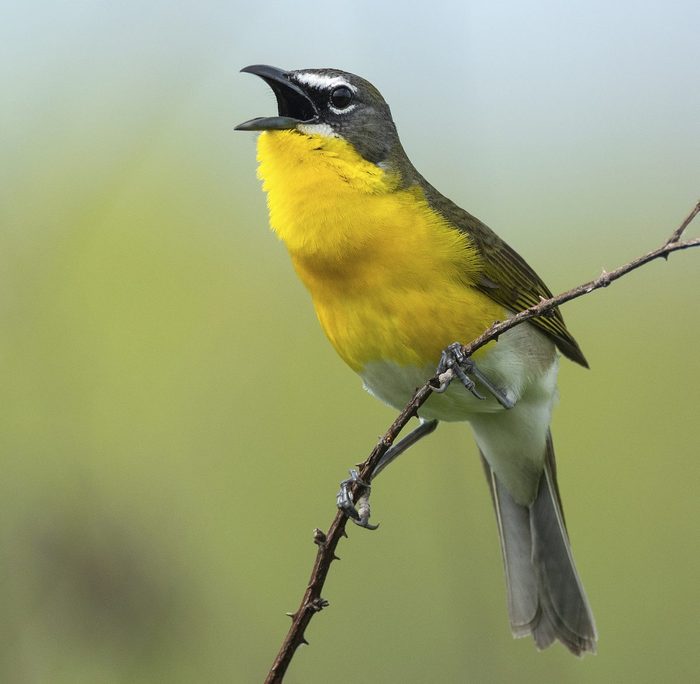
Chats have unmistakable cackles, clucks, whistles and hoots. The American Bird Conservancy quotes ornithologist Arthur Cleveland Bent, who observed “a medley of strange sounds”—catcalls, whistles and various bird notes—“betray the presence of this furtive and elusive clown among birds.”
Bird sounds courtesy of the Cornell Lab of Ornithology
Meet the vireo bird family: sweet summer singers.
About the Expert
David Wiedenfeld is a senior conservation scientist at the American Bird Conservancy. Earning a PhD from Florida State University, his scientific work has focused on prairie-chickens, parasites, and invasive species.
Sources
- Interview: David A. Wiedenfeld
- American Bird Conservancy
- National Audubon Society
- Department of Energy & Environmental Protection – State of Connecticut
- All About Birds
On springtime or early summer walks through the woods, you might find yourself surrounded by purple flowers and think, “Wow, look at all that lovely phlox!” But do a double take, because you might be seeing a troublesome phlox look-alike. Unfortunately, the object of your admiration could be an invasive species: dame’s rocket.
While dame’s rocket and phlox flowers look incredibly similar, you can learn tips and tricks to tell them apart. By learning the difference, you can make sure that what you’re seeing really is phlox—and that you’re not letting an invasive flower take control of your yard. Here’s what you need to know about dame’s rocket vs phlox.
On This Page
Identifying Dame’s Rocket
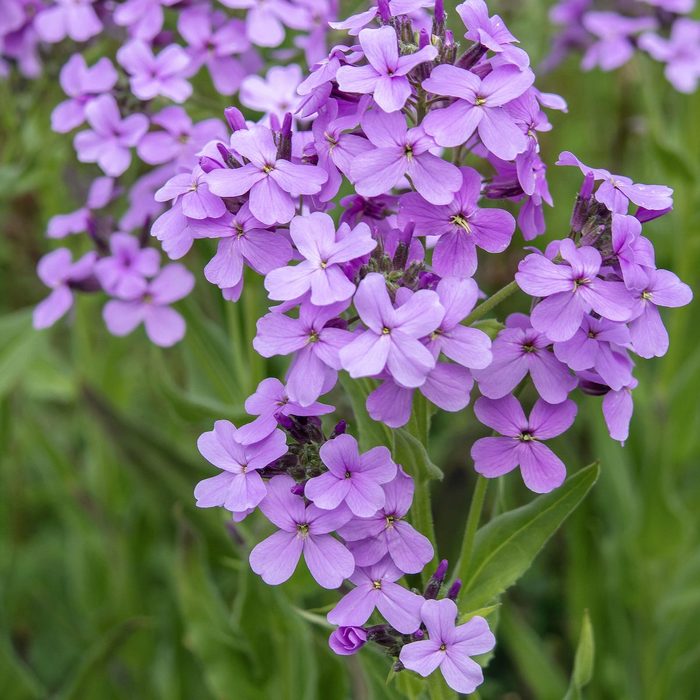
- Botanic name: Hesperis matronalis
- Zones: 3 to 9
To identify dame’s rocket (Hesperis matronalis), look for four-petaled pink, purple or white clustered flowers. Its leaves grow in lance shapes, and orient themselves singly on alternating sides of the stem. Those leaves are smooth. Growing in Zones 3 to 9, it typically reaches heights of 3 to 4 feet tall.
Although dame’s rocket seeds can be found in some “native” wildflower mixes, it is an introduced plant that is considered invasive in several states. Gardeners should read the contents of seed mixes before purchasing to avoid buying those that contain dame’s rocket.
To control its spread, remove dame’s rocket before it seeds. This plant is a biennial that will have only foliage the first year, and then will flower and seed the second year.
Wildflower identification 101: here’s how to get started.
Identifying Phlox
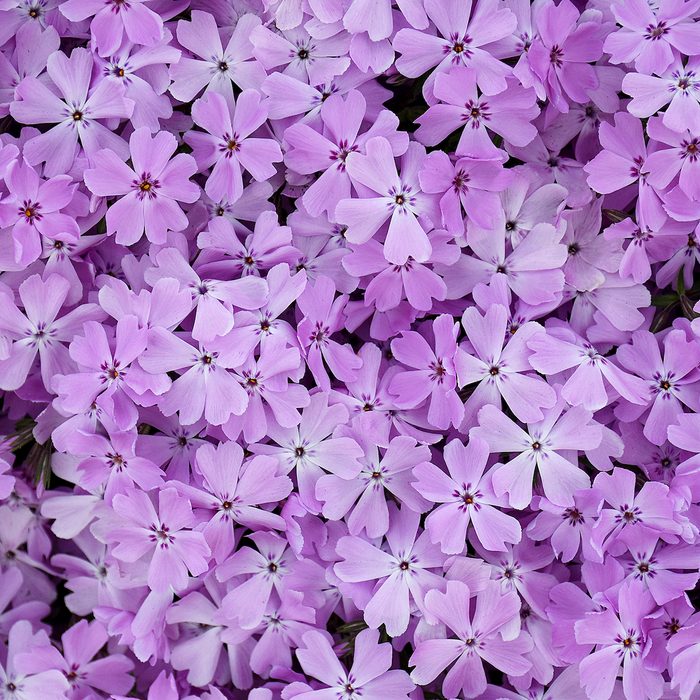
- Botanic name: Phlox spp.
- Zones: 3 or 4 to 9, depending on variety
To identify phlox (Phlox spp.), look for tight bunches of five-petaled flowers that come in almost every color. Some varieties have hairy leaves, while others are smooth. Those lance-shaped leaves grow opposite each other in pairs on the stem. Phlox grows in Zone 3 or Zone 4 to 9, depending on the specific variety. Plant heights can vary, with a range of 6 inches up to 4 feet.
For gardeners who want to get the most out of their phlox, consider consistent deadheading to encourage more blooms.
Phlox vs Dame’s Rocket: Key Differences
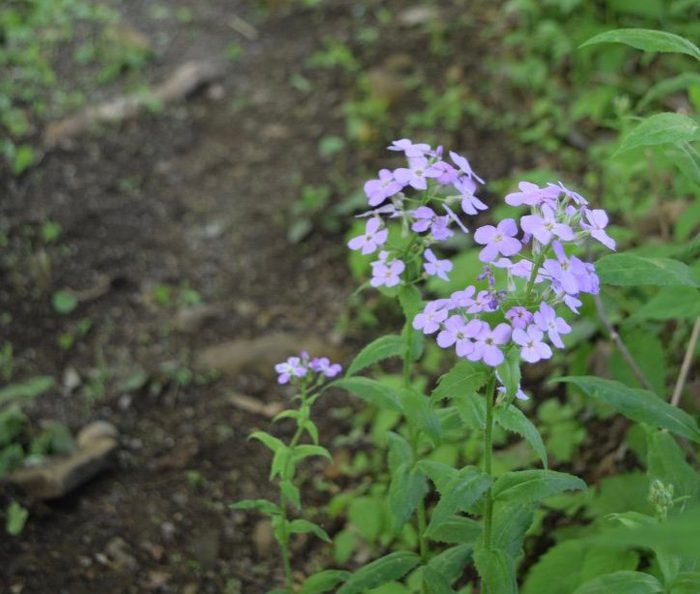
While these flowers have many similarities, it’s possible to them apart from each other at a glance.
One key difference? The number of petals on the flowers. Dame’s rocket has four flower petals, while phlox has five. In addition, if your plant has hairy leaves, there’s a good chance it’s phlox—dame’s rocket leaves are smooth.
If you’re dealing with dame’s rocket, learn how to remove invasive plant species for good.
Sources
- The Ohio State University
- South Dakota State University Extension
- Spring Hill Nursery
- University of Wisconsin Extension
- USDA Forest Service
- Proven Winners
Why Trust Us
For nearly 30 years, Birds & Blooms, a Trusted Media Brand, has been inspiring readers to have a lifelong love of birding, gardening and nature. We are the #1 bird and garden magazine in North America and a trusted online resource for over 15 million outdoor enthusiasts annually. Our library of thousands of informative articles and how-tos has been written by trusted journalists and fact-checked by bird and garden experts for accuracy. In addition to our staff of experienced gardeners and bird-watchers, we hire individuals who have years of education and hands-on experience with birding, bird feeding, gardening, butterflies, bugs and more. Learn more about Birds & Blooms, our field editor program, and our submission guidelines.
On This Page
What Is No Mow May?
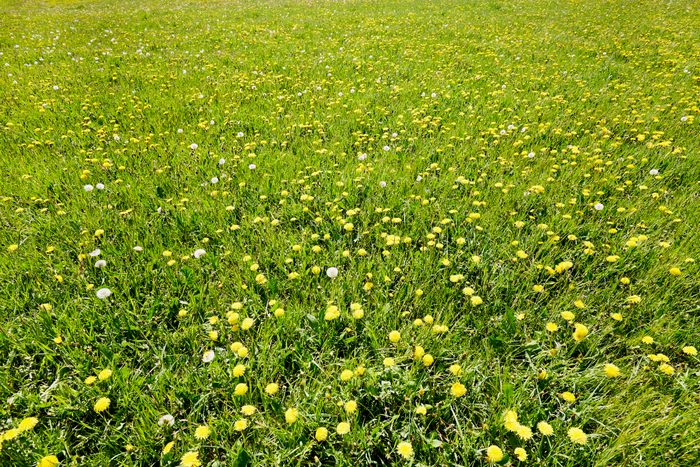
You’ve probably heard about No Mow May on social media or seen yard signs signifying participation and might want to give it a go. A growing trend on the garden and landscaping scene, it encourages delaying the first mow of the season to temporarily create a more biodiverse and hospitable habitat for pollinators awakening after winter—bees in particular.
Despite its admirable goal and seemingly simple execution, No Mow May might not be the best approach for everyone. Before foregoing the first mow, consider the following factors and some less controversial options.
Learn how to grow a pollinator garden.
Pros and Cons of No Mow May
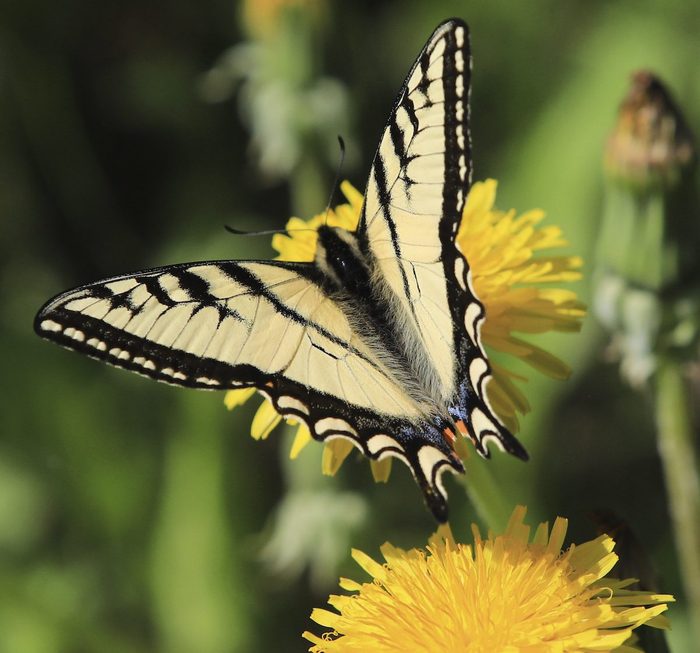
One advantage of this viral movement has been increased recognition of certain insects and their needs. “No Mow May has helped with awareness, to the point that some people now think National Pollinator Month is May and not June due to the public attention it has received,” says Birds & Blooms horticulture expert Melinda Myers.
And since it’s as easy as leaving your mower in storage for an extra month, it’s a low-commitment entry into the world of caring for pollinators. But it does have some downsides.
The pollinators that revel in your lush, unmowed lawn will likely return later, only to find a harsh surprise once their food sources have been sheared away. Or worse yet, bugs and critters who make their homes in uncut lawns may not survive a big chop at the end.
Then there’s the unkempt look. Some people want to help but prefer a well-maintained green space. Fortunately, other pollinator-friendly practices could help avoid these outcomes and better fit your style.
Follow these tips for growing a healthy lawn.
Do Some Research Before You Participate
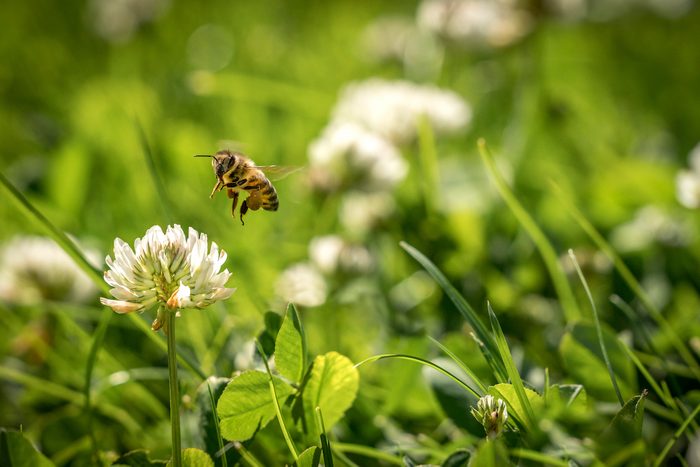
If you do plan to pause mowing, there are some important factors to investigate beforehand. The first is timing. No Mow May started in the United Kingdom, so even though it’s a catchy slogan, May might not be the best month for every region. The objective is to allow growth of flowering pollen sources, such as dandelion and clover. You’ll want to avoid mowing when they are in peak bloom.
If your lawn is treated for weeds, hold off on that too. “I have heard from lawn care companies that some customers who have their lawns treated regularly participated in No Mow, only to realize the treatments had already eradicated the pollinator plants,” Melinda says.
Furthermore, local ordinances and homeowners association rules vary, so determine what is allowed in your area before proceeding. If your city has a limit on grass height, try talking to the city council about exemptions. Encourage them to consider the merits.
Go lawn free: plant a prairie garden.
Share the Message With No Mow May Signs
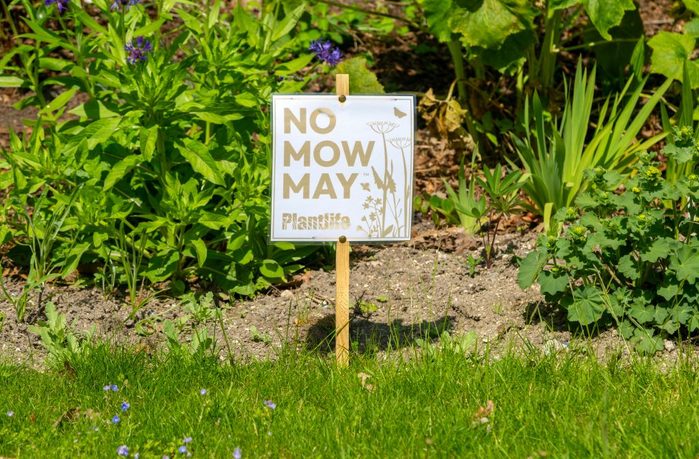
If your area supports the movement, see if they offer yard signs to help educate and engage your neighbors. A sign could also quell any disapproval of the less-than-tidy look!
Finally, keep in mind that it could be difficult and detrimental to tackle the immense growth at the end of the month. Lower the height of your grass slowly over several mows. This avoids sending it into shock and gives pollinators a chance to realize it’s being cut back.
Here’s what you need to know about native plants.
No Mow May Alternatives Abound
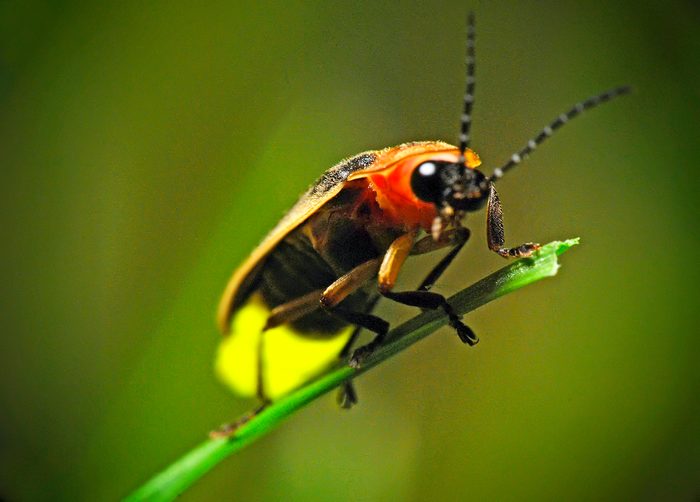
If you want to try a more intentional or long-term tactic, there are options for every level of commitment. Ease into it by decreasing your mowing frequency with a “Less Mow May.” You can also try reducing the use of chemicals and pesticides harmful to bees and their food sources.
Try pocket planting, which, as the name implies, is the practice of creating smaller areas with specific vegetation. This approach also works well in yards with limited space and municipal restrictions.
If you have the room and freedom and are ready to put in more effort, consider meadowscaping. This essentially rewilds your urban yard into an ecologically beneficial meadow. Once established, it can be very low maintenance.
Whether you nix mowing or take another pollinator-friendly path, discussing details with your local extension office is always a good first step. No matter the size or commitment, any amount of space or time you can offer pollinators will help.
About the Expert
Melinda Myers is the official garden expert for Birds & Blooms. She is a TV/radio host, author and columnist who has written more than 20 gardening books. Melinda earned a master’s degree in horticulture from the University of Wisconsin-Madison.
Sources
- National Garden Bureau
- Minnesota Public Radio News
- The Ohio State University
- American Meadows
- Better Homes & Gardens
- Blue Thumb
Why Trust Us
For nearly 30 years, Birds & Blooms, a Trusted Media Brand, has been inspiring readers to have a lifelong love of birding, gardening and nature. We are the #1 bird and garden magazine in North America and a trusted online resource for over 15 million outdoor enthusiasts annually. Our library of thousands of informative articles and how-tos has been written by trusted journalists and fact-checked by bird and garden experts for accuracy. In addition to our staff of experienced gardeners and bird-watchers, we hire individuals who have years of education and hands-on experience with birding, bird feeding, gardening, butterflies, bugs and more. Learn more about Birds & Blooms, our field editor program, and our submission guidelines.
On This Page
What Does an American Crow Look Like?
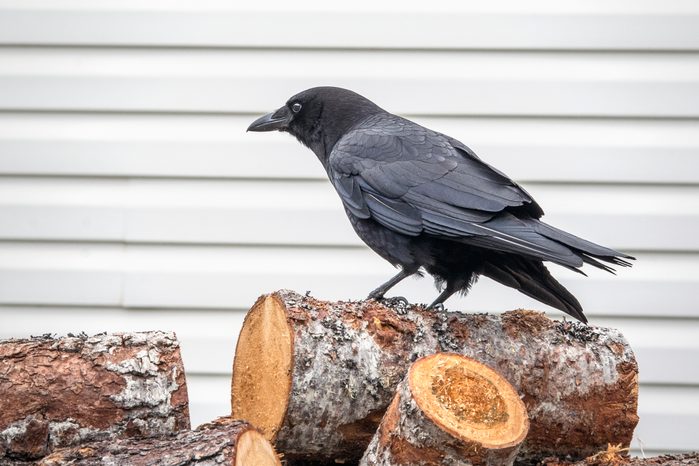
It’s pretty much impossible to miss an American crow (Corvus brachyrhynchos). These large, completely black birds in the corvid family tend to travel in flocks ranging from a handful of birds into the hundreds of thousands. Crows can measure up to 20 inches from their large, thick beak to their tail, and they can weigh as much as 20 ounces.
It’s nearly impossible to tell male and female crows apart. The only way to differentiate between them is if they’re sitting close—then, a slight difference in size might be noticeable. Males are generally larger than females.
Here’s how to tell the difference between similar-looking ravens and crows.
Crow Nests and Eggs
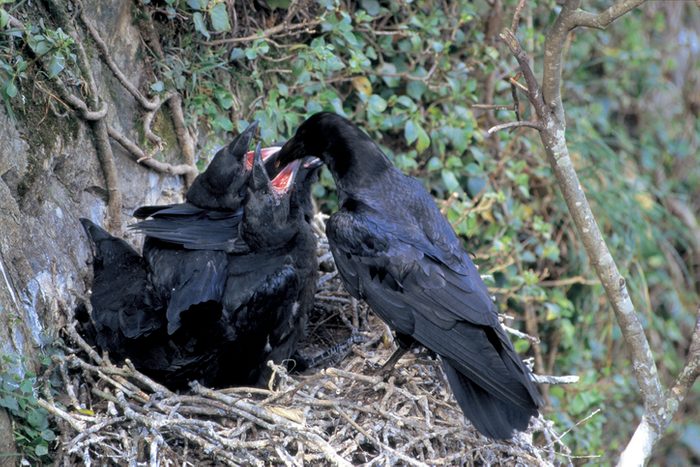
Typically American crows build their nests high off the ground. Both halves of a mated pair help in its construction; young from previous broods may also pitch in. Nests are usually made from twigs, and a soft lining rests on the inside.
Crow eggs are usually approximately 2 inches in length and 1 inch in width. They can be blue-green or green in color, with brownish spots.
Psst—baby crows are much cuter than you think.
American Crow Call and Sounds
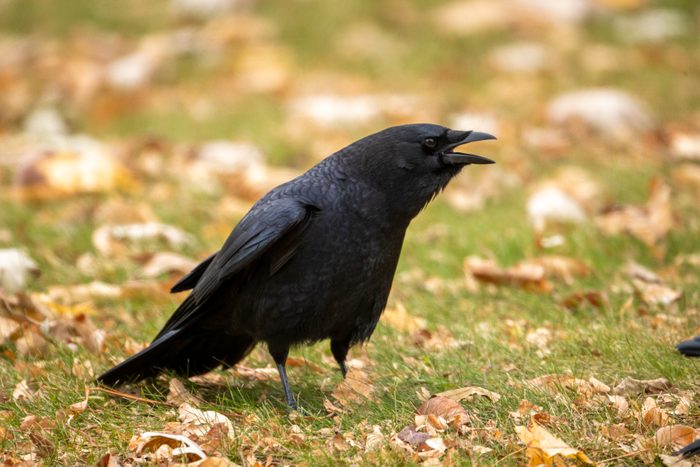
The crow’s typical vocalization is no secret: a harsh, loud caw-caw-caw. That’s hardly their only noise, though. American crows, like the rest of their corvid family members, can make a variety of sounds which include rattling croaks, gurgles and snapping their beaks.
Bird sounds courtesy of the Cornell Lab of Ornithology
If you’ve ever wondered, this is why crows chase hawks.
What Do American Crows Eat?
Some might say crows are the raccoons of the bird world. They’ll chow down on pretty much anything, including stomach-churning stuff. You might’ve heard rumors that crows eat carrion, and those rumors are true. They’ll also munch on garbage… and the eggs or young of other birds.
Before you clutch your pearls, take note that they’re hardly the only species to do this. Some jays, herons and woodpeckers rob nests, too!
Crows will swoop in to snag insects, snakes or fish, and they’ll eat fruits and vegetables, too.
Meet the fish crow: the American crow’s coastal cousin.
Do Crows Visit Bird Feeders?
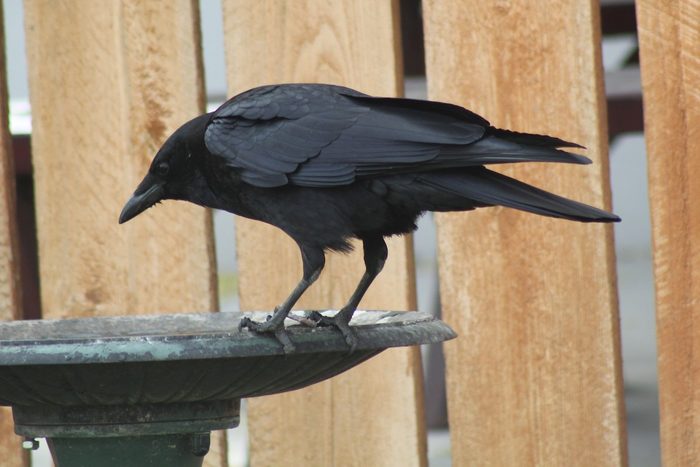
Crows don’t typically eat birdseed that’d draw in your favorite songbirds like cardinals and goldfinches. They tend to root around for their food, which makes them a rare sight at backyard feeders. (Also rare: spotting an albino crow.) You’re more likely to see grackles and blackbirds, instead.
With that said, crows, like their blue jay relatives, do enjoy eating peanuts. By putting out a platform feeder packed with peanuts in or out of the shell, you might be able to draw them in. You can try a ground feeder as well, since they like to dine on the ground. As with many birds that don’t come to feeders, it’s possible to attract American crows with a bird bath.
If you see a crow at your backyard feeding station, look closely and you might spot some usual bird behavior.
“A few American crows visit my platform feeder for shelled peanuts. Instead of eating the peanuts right away, the crows take them over to the birdbath, dunk them in the water, then eat them. Why do they do that?” asks Birds & Blooms reader Sandy Hannemann of Mequon, Wisconsin.
Birding experts Kenn and Kimberly Kaufman explain, “Although it’s rare for most birds to dunk their food, this odd habit has been observed many times in grackles and crows. No one knows why they do this. Dunking might soften certain foods but wouldn’t affect hard items like peanuts. It’s not to clean their food either, since they sometimes dip clean food into muddy water.
Some have suggested that crows get food wet to take moisture back to their nestlings, but they dunk food even in seasons when they’re not feeding young. So the behavior remains a fascinating mystery.”
Learn how to identify Steller’s jays: clever black and blue birds.
What Is a Group of Crows Called?
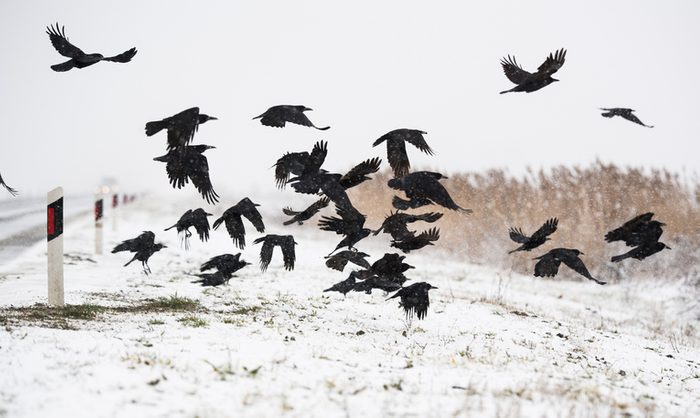
While there exists a wide variety of amusing names for groups of birds—a “parliament” of owls, for example—you’re not soon to forget the name for a gathering of crows. Referred to collectively as a “murder,” the name ties back to ancient superstitions that cast crows as an omen of impending death or destruction.
However, there’s no reason to be scared of their bad reputation. Keep in mind that crows and other corvids are considered some of the smartest birds, too.
Here’s what it means if you see a crow.
American Crow Range and Habitat
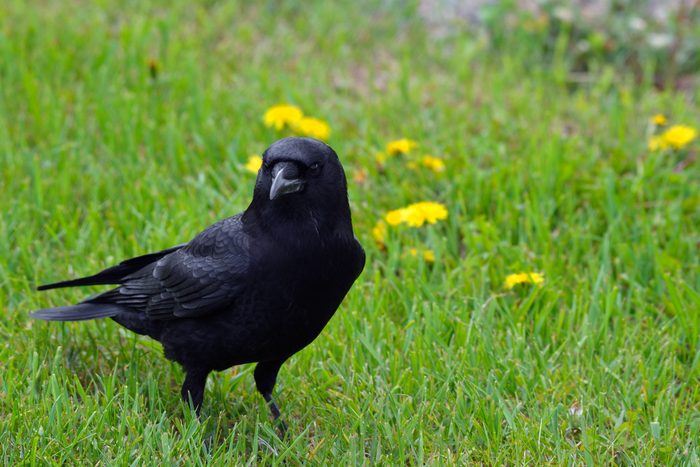
There’s no need to fret about saving up for a special birding trip to spot an American crow. If you’re in the U.S., chances are decent that they’re already flying around your neighborhood. These birds adapted well to city living, so they’re as at home among skyscrapers and in suburbs as in groves of trees.
Their year-round range stretches through most of the United States with the exception of a few northernmost Midwest states and Canada, where they only spend the breeding season.
Next, learn interesting facts about common ravens.
Sources
- Cornell Lab of Ornithology – All About Birds
- National Audubon Society
- Merriam-Webster dictionary
- Nature – PBS.org
About the Experts
Kenn and Kimberly Kaufman are the official birding experts for Birds & Blooms. They are the creators of the Kaufman Field Guide series and they speak and lead birding trips all over the world.
Why Trust Us
For nearly 30 years, Birds & Blooms, a Trusted Media Brand, has been inspiring readers to have a lifelong love of birding, gardening and nature. We are the #1 bird and garden magazine in North America and a trusted online resource for over 15 million outdoor enthusiasts annually. Our library of thousands of informative articles and how-tos has been written by trusted journalists and fact-checked by bird and garden experts for accuracy. In addition to our staff of experienced gardeners and bird-watchers, we hire individuals who have years of education and hands-on experience with birding, bird feeding, gardening, butterflies, bugs and more. Learn more about Birds & Blooms, our field editor program, and our submission guidelines.
On This Page
What Does a Canada Warbler Look Like?
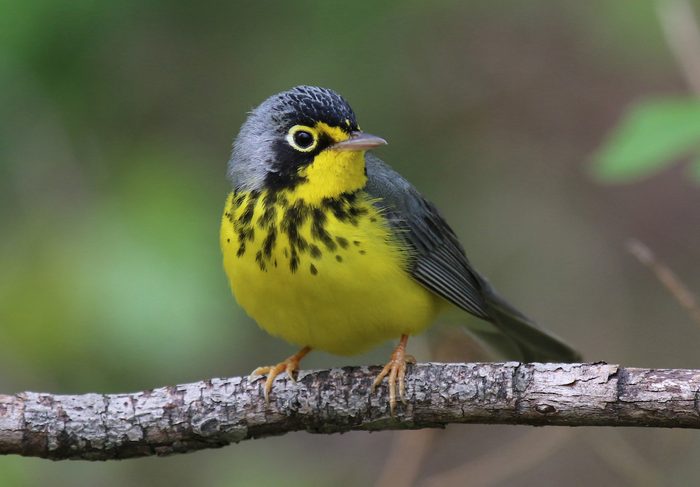
Doug Hitchcox, staff naturalist with Maine Audubon, says, “Canada warblers are easily recognizable thanks to the fairly unique plumage of slate-blue above, yellow below, with a wide ring around the eye best described as ‘spectacles’ and a restricted black necklace across the chest. The magnolia warbler is superficially similar but has white markings on the wings, more black extending down the flanks for its necklace, and a patch of yellow on their rump (not to be confused with the yellow-rumped warbler).”
According to Doug, if you want to know if a Canada warbler is a male, female or juvenile, pay close attention to the vibrance of the bird’s plumage.
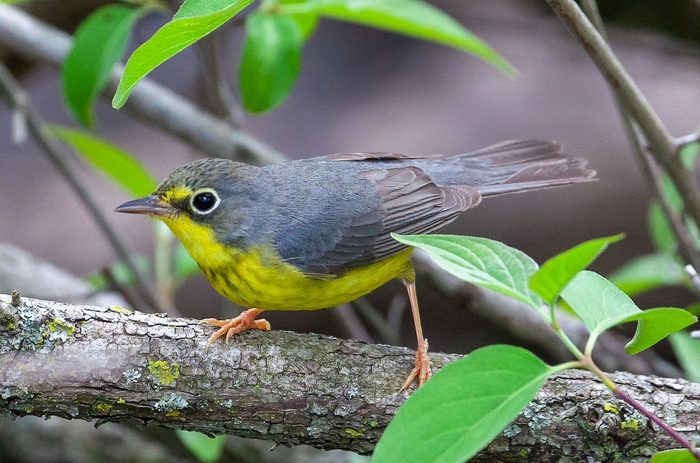
“Think of their plumage on a scale from brightest and boldest on one end to drab and unmarked on the other,” he says. “Adult males would be plotted closest to the bright and bold end thanks to the sharp contrasts in their markings. Adult females show similar field marks but toned down, especially lacking the dark facial markings and showing a muted black necklace. Younger birds continue down that scale, getting progressively duller but fortunately still retaining enough of the classic field marks to be easily recognizable.”
Learn how to identify a palm warbler.
Range and Habitat
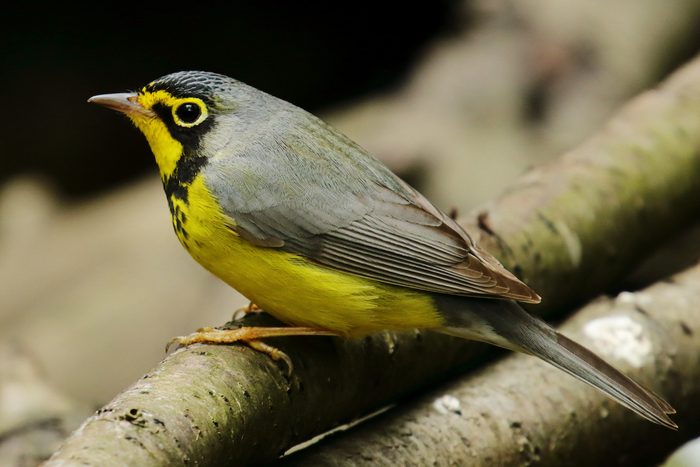
Doug says, “Canada warblers are a classic boreal forest breeder with most of their summer range falling, appropriately, in Canada’s boreal forest, but extending south into northern states with appropriate habitat and along higher elevations of the Appalachian Mountains. In our winter, they are primarily in the Northern Andes, south to Peru.”
Breeding Bird Survey data shows Canada warbler population numbers are declining. Doug has a suggestion for how birders can help them. “This species can often be found in coffee plantations in its winter range, which is a good reminder that bird lovers should purchase shade-grown ‘bird friendly’ coffee to help protect the areas that these birds are using in the winter.”
If you want to spot these warblers, you need to know the habitat they prefer.
“These birds are often found near open water, probably because it provides much of the food (winged insects) that they are looking for,” Doug says. “They can be found in mixed forests, but need a dense understory if they want a place to nest.”
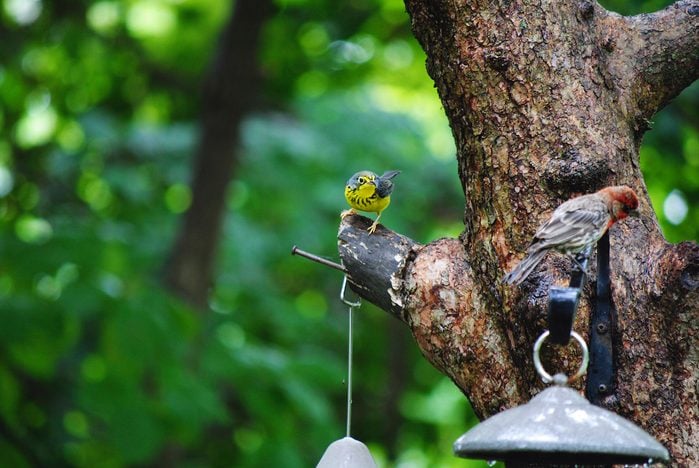
“I have never seen this pretty yellow bird before. I think it is a Canada warbler (above). Is this a rare sighting in my area?” asks Birds & Blooms reader Lisa Trimble of Delanco, New Jersey.
Birding experts Kenn and Kimberly Kaufman say, “Yes, this is a Canada warbler, probably a female or a young bird. Late August is well within the period of their fall migration, when Canada warblers leave their nesting grounds for their winter range in South America. Although this species is a regular migrant through your general area, it often hides in thickets or forest undergrowth, so it’s a rare treat to have one as a backyard visitor.”
Diet: What Do Canada Warblers Eat?
You’re unlikely to see this bird on your backyard sunflower seed feeder but it might visit your bird bath.
“Canada warblers are obligate insectivores, favoring flying insects like flies and mosquitoes. This is why they travel to the boreal forest in our summer,” says Doug. “It is rare for them to visit backyards, though a water feature would be more appealing than almost any bird food we would provide.”
He also emphasizes the importance of including native plants in our yards to support native insects that the birds feed on.
Learn more about what warblers eat and how to attract them.
Nesting Habits
As a surprise to many, Canada warblers typically build their nests on the ground. “They’ll find a spot on a slight slope, preferably with an overhang, where they’ll construct a small nest from woven plant matter. The female does most of the actual nest building, but the male does help collect materials,” Doug says.
This is not a species that mates for life. Doug explains, “While both parents have roles in raising the young, making them ‘socially monogamous,’ studies have shown that about half of all nests had genes from multiple males contributing.”
Learn how to identify an American redstart.
Canada Warbler Song
Bird songs courtesy of the Cornell Lab of Ornithology
“Canada warblers do have a distinctive song but it doesn’t have an easily memorizable gimmicky mnemonic like many of the other warblers,” Doug says. “The song is a rapid series of short bubbly notes, but the most unique part is the first note—a quick pop of noise that stands out a bit from the rest of the song. Remembering the first note as if the warbler stubbed its toe before shouting out a bubbly expletive is the best cue I can give for someone listening for this bird.”
About the Experts
Doug Hitchcox is the staff naturalist for Maine Audubon. He answers reader questions about birds and wildlife in the Maine Sunday Telegram/Portland Press Herald.
Kenn and Kimberly Kaufman are the official birding experts for Birds & Blooms. They are the creators of the Kaufman Field Guide series and they speak and lead birding trips all over the world.
Why Trust Us?
For nearly 30 years, Birds & Blooms, a Trusted Media Brand, has been inspiring readers to have a lifelong love of birding, gardening and nature. We are the #1 bird and garden magazine in North America and a trusted online resource for over 15 million outdoor enthusiasts annually. Our library of thousands of informative articles and how-tos has been written by trusted journalists and fact-checked by bird and garden experts for accuracy. In addition to our staff of experienced gardeners and bird-watchers, we hire individuals who have years of education and hands-on experience with birding, bird feeding, gardening, butterflies, bugs and more. Learn more about Birds & Blooms, our field editor program, and our submission guidelines.